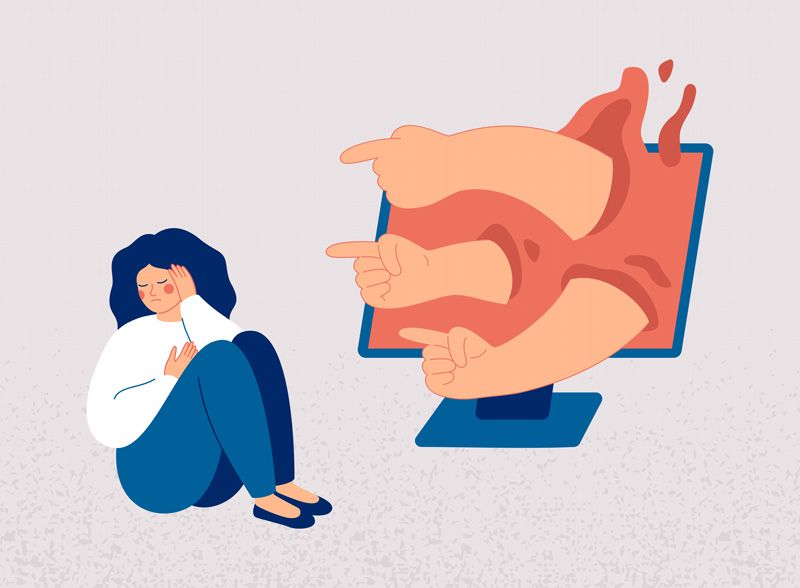Domestic Abuse Takes Many Forms
1 out of every 2 people in California, including children, have been exposed to domestic violence, according to new research by the Blue Shield Foundation of California. Nationally, 1 in 4 women and 1 in 7 men will experience physical violence by their intimate partner at some point during their lifetimes, according to CDC data.
Domestic violence can take many forms. Technology abuse – stalking, harassing someone by text, using apps to track their whereabouts; and Coercive Control are two forms of violence that often go unreported.

At an Ethnic Media Services briefing, held Oct. 28, speakers – Jenna Lane, Communications Officer, Blue Shield Foundation of California; Erica Olsen, Director of the Safety Net program at the National Network to End Domestic Violence; Deborah Tucker, President of the Board of Directors at the National Center on Domestic and Sexual Violence; and Pallavi Dhawan, Director of Domestic Violence Policy for the Los Angeles City Attorney’s Office – focused on DV via technology, coercive control, policy at the California state level, and policy changes emerging from the Biden administration, including the expansion of the Violence Against Women Act and the White House plan. Speakers also addressed whether immigrants are more vulnerable to abuse because they lack the resources and support for help.
Jenna Lane, a communications officer with Blue Shield of California Foundation shared information on letsenddv.org.
“More than half of Californians have up close and personal experience of domestic violence. It is truly everywhere, which is troubling, but that does not have to be overwhelming. Instead, it can be powerful. We’re not alone, and together we can solve this problem.
“With a wide range of controlling and abusive behaviors, domestic violence is more than the physical injuries that come to mind for many people.
“It can also be emotional; financial, like controlling someone’s money or getting them fired from their job; technological; legal, like threatening to call Immigration on someone; social, preventing someone from seeing their family and friends – This range of controlling behaviors can be summed up by talking about Coercive Control.
“It is very important to help people in crisis, but if we as a society don’t also help them and their families to heal, domestic violence will keep happening,” said Lane.
Pallavi Dhawan, Director of Domestic Violence Policy for the Los Angeles City Attorney’s Office, whose office was key to passing a Coercive Control measure in California SB 1411, spoke next.
“Coercive Control is domestic violence. Typically, in our society the person with less power is the woman and it is especially the woman of color and the immigrant woman.
“Domestic violence and coercive control occur in every culture and across racial, ethnic, and economic lines, but the prevalence of coercive control and domestic violence is higher among women of color, particularly immigrant women, and this is because of the nature of coercive control as a pattern of domination and power exerted over another person’s autonomy.
“The tactics that are used to control victims in an intimate partner relationship, isolation, monitoring, deprivation of resources, as a few examples are encouraged and enabled in intimate partner relationships, because society and larger systems perpetuate these imbalances, and this creates distrust amongst survivors and reluctance among survivors to seek help.
“The reluctance to seek help and the distrust among survivors is elevated for women of color and marginalized communities who already face unique barriers in seeking help such as cultural pressures to keep matters private, to maintain a family’s sense of honor.
“Experiences with racism on a systemic level or worries about negative immigration consequences from reporting, coercive control in intimate partner relationships reinforces these barriers to reporting and seeking help, allowing the abuser to maintain control by exploiting systemic inequalities, and wielding these as weapons of power and control in the relationship.
“It’s hard to measure the prevalence of coercive control. There’s a lack of data and that is related in part to definitional variation in studies and we’re not necessarily hearing from everyone who is experiencing the abuse.
“We crafted a bill that now codifies coercive control in the California Family Code allowing victims of this form of abuse to seek restraining orders prohibiting coercive control and requiring courts to consider evidence of coercive control in child custody determinations.
“Coercive control is defined in the Family Code as a liberty deprivation. It is a pattern of behavior that in purpose, or effect, interferes with a person’s free will and personal liberty,” said Dhawan.
Erica Olsen, Director of the Safety Net program at the National Network to End Domestic Violence spoke about technology abuse and its growing prevalence.
“Many abusers misuse technology as a tactic to further abuse and harm. It’s an incredibly common tactic that crosses all forms of domestic violence, social assault, stalking, and abuse.
“Technology abuse can include things like harassing somebody by repeatedly texting and calling; monitoring smart devices to make someone feel isolated and unsafe in their home; tracking someone’s location without their knowledge; or hijacking financial or social accounts to commit fraud or impersonation.
“It’s a very common one that we see distributing intimate images without consent or posting threats or harassing content online, and these are just some of the most common examples,” said Dhawan.
“As technology evolves, we see the tactics of misuse evolve alongside. There are constantly new tactics where abusers are misusing technology to further harass, isolate, cause fear.
“It’s important to know that technology can also be a very powerful tool for survivors.
“We want to focus on empowered and safe use of technology by survivors,” said Dhawan.
“Some abusers may install hidden apps or monitoring software on a partner’s device without their knowledge; some may misuse social media sites or smart devices in the home, to harass or stalk,” said Dhawan.
“A 2021 Pew Research study also found that almost half of adults had experienced some form of online harassment. Their research also noted that victims who are Black and Hispanic are twice as likely as White victims to report the experience as being extremely upsetting women of color are often targeted with violent threats that are racialized and sexualized in nature and this can lead to an increase in trauma, and also additional burdens such as employment loss or relocation costs.
“Financial struggles can also prevent survivors from accessing or replacing technology, and this increases the digital divide which creates barriers to accessing advocacy or services and legal support. Immigrant and LGBTQIA survivors may also face disparities in technology access which furthers isolation.
“There is some good news. The Biden Harris Administration recently launched the White House task force to address online abuse and harassment.
“We were asked to bring some suggestions to the task force on addressing online abuse and some of those included increasing access to technical experts, to assist survivors and advocates in assessing technology abuse.
“We also suggested creating and enhancing programs that promote digital equity, increasing survivors access to information about tech abuse, privacy, and security, and supporting efforts to establish online norms based in consent and respect.
“The March uh 2002 reauthorization of the Violence Against Women Act included a comprehensive definition of technology abuse, which is important because it really helps service providers, advocates and others to better understand this issue,” said Dhawan.
VAWA 2022 also created a civil action for non-consensual image sharing, which gives survivors an option to go to court, to recover monetary damages, and access and order protection.
“NADV was also a proud to endorse the technology safety for victims of domestic violence; dating violence; sexual assault; and stalking act,” said Dhawan.
Deborah Tucker helped to craft and secure passage of the landmark Violence Against Women Act in 1994. She discussed the national policy – what we can expect to see in the proposed White House plan, and the expansion of the Violence Against Women Act.


